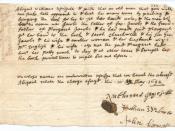From its ominous opening, to its dad ending, "The Crucible" by Arthur Miller is a play driven by fear and desire, mirroring the McCarthy trials of the Communist hating 1950ÃÂs. Though its set in 1692, the tone of the play and the themes of intolerance, hysteria, and ruined reputation were very prominently felt during 1953, when the play was published. The title, and the actual item of a crucible, suggests something seemingly solid melting away under immense stress. The hard structure of society in puritanical America and the spotless reputations of many good folk melt away to nothing in the fire of fear and trials caused by accusations of witchcraft. Miller uses the imagery of the crucible in the play also, in a quote from Mr. Danforth, ÃÂWe burn a hot fire here, it melts down all concealmentÃÂ, though what ends up being revealed is the fear and intolerance that control their society.
The protagonist, John Proctor, has before the opening if the play had and ended an affair with the Antagonist, Abigail Williams. In this telling of the beginning of the witch trials, it is AbigailÃÂs desire for revenge that leads the girls into the woods to perform a magic spell against JohnÃÂs wife Elizabeth. It is dialogue between Abigail and John, and later dialogue of the confession of some of the girls, which reveals the affair between them and AbigailÃÂs deep desire to have John back at any cost. John is attempting to right his wrong in the affair between himself and Abigail, but spurning her only causes more tension. When Abigail cannot easily win john back, and faces punishment for her actions in the woods, she turns the townÃÂs fear of witchcraft and the girlÃÂs hysteria into her own device for revenge, at any cost. The playwright...



Good but
This is such a indepth play and could have gone into alot more detail. However this is excellent if the world limit is short.
1 out of 1 people found this comment useful.